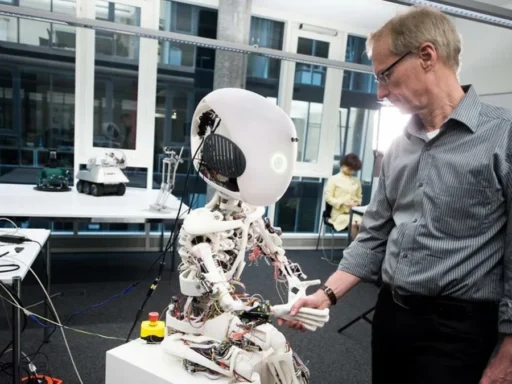Ever stared at a math problem wondering if your brain just quit? You’re not alone. Every day, students, engineers, and even rocket scientists run into equations that seem like they’re written in alien code.
Here’s the good news: AI math solvers are changing the game. They’re not just calculators—they’re smart tools that explain why x equals 7, not just tell you it does.
These tools let you snap a pic of a handwritten equation, run complex calculus in seconds, and even get feedback tailored to how you learn. Whether you’re prepping for a test, building financial models, or programming a simulation—you don’t have to do math the hard way anymore.
And trust me, the best AI math solvers out there aren’t just flashy apps—they’re bending the rules of how we understand and apply mathematics. Let’s break down what these tools really are, what they can do, and why they’re way more than just homework helpers.
Introduction To AI Math Solvers And Their Impact
Imagine having a math coach that never sleeps, doesn’t judge, and knows practically every equation ever written. That’s what AI math solvers bring to the table. At their core, these tools use machine learning and language models to recognize math problems, solve them, and explain the steps—just like a seasoned tutor.
They’re not just digital calculators. They’re built with AI that understands patterns, applies logic, and interprets complex math beyond basic arithmetic.
Here’s what makes them powerful:
- They analyze your problem, not just the numbers
- They walk you through the process so you learn, not memorize
- They adapt—from basic algebra to Olympic-level calculus
The impact? Massive.
We’re seeing AI math solvers reshape education, automate parts of engineering research, and even plug into scientific simulations. They cut the fluff and speed things up where precision matters most—labs, factories, classrooms, even groundbreaking AI research itself.
DeepMind’s AlphaGeometry didn’t just do geometry. It tackled Olympiad-level problems and nailed 25 out of 30—performing on par with global math prodigies. This isn’t “ed-tech.” This is innovation bleeding into everything from theorem proving to scientific breakthroughs. (source)
The Game-Changing Features Of AI Math Solvers
Forget boring flashcards and generic calculators—AI math solvers today are razor-sharp. They don’t just outsource the grunt work. They elevate your ability to engage with math even if you’re more “visual learner” than “numbers person.”
Let’s break down what’s under the hood.
Intelligent Problem-Solving And Algorithmic Capabilities
At the heart of these solvers are deep neural networks and rule-based symbolic engines. These algorithms aren’t just parsing equations—they’re disguising high-level computation as simple, click-and-learn workflows.
They:
– Break multi-step calculations into teachable steps
– Verify accuracy before outputting a result
– Recognize real-world math applications (like physics curves or financial ratios)
This combo of logical precision and context awareness is why these tools are trusted in research labs and classrooms alike. It’s not just about correct results; it’s about understanding every move that gets you there.
AI-Powered Algebra And Geometric Calculators
AI doesn’t freeze when it sees the word “prove” in a geometry problem.
Tools like AlphaGeometry use symbolic reasoning and deep learning to crush Euclidean geometry problems. At the 2024 International Math Olympiad, Google’s AlphaProof and AlphaGeometry 2 solved four out of six high-difficulty problems—matching or outperforming some of the world’s brightest human competitors (source)
Here’s where they excel:
| Tool | Specialty | Benefit |
|---|---|---|
| AlphaGeometry | Olympiad-level geometry | Symbolic reasoning + deep learning |
| Julius AI | Equation modeling & proofs | Ideal for technical and academic users |
| GeoGebra | Visual math (geometry & algebra) | Interactive learning experience |
Real-Time Computation For Complex Math Problems
Let’s be real—nobody wants to spend 40 minutes solving one triple integral.
AI speeds that up.
Most high-end math solvers now handle:
– Multivariable calculus
– Linear algebra transformations
– Probability distributions with custom variables
They’re also being used in real-time workflows. Engineers run simulations. Financial analysts model stock volatility. Even pharmaceutical researchers model data flow in disease progression—all using AI to crunch numbers fast and with fewer human errors.
Accessibility For All Skill Levels: From Students To Professionals
You don’t need a math degree to use these tools.
There’s a growing class of educational AI apps and tutoring systems that simplify complex operations without dumbing them down.
Take Rori AI, an app running on WhatsApp, used by over 1,000 students in Ghana. It showed an effect size of 0.37 in learning growth—more than some human-led curriculum tweaks ever did (source). No fancy UI. No parent tech support. Just pure math momentum on a messaging app.
For professionals, platforms like Julius AI get the job done with detailed, audit-ready results and less back-and-forth debugging.
Top AI Math Solvers: Reviews And Features
The apps and platforms leading the AI math space didn’t get there by just solving algebra.
Here are the top tools that earned their spot in student backpacks and research labs alike:
Photomath
Use your camera. Get step-by-step answers.
That’s the appeal of Photomath, which crushed it by making math as fast as snapping a selfie. It works across topics—fractions, quadratic equations, even word problems. Perfect companion for late-night cram sessions or adding explanation to what the teacher rushed through.
Julius AI
If you lean technical—data scientist, engineer, analyst—this one shines.
Julius AI delivers breakdowns and advanced modeling, not just raw answers. Trusted by over 1.2 million users because it doesn’t compromise on depth.
Socratic by Google
More than a solver—it’s a textbook with personality.
Socratic blends Google’s AI with clean, student-focused content. Snap a problem, and it’ll teach you the “why” using visuals, videos, and comparisons. Solid for middle and high school learners needing that extra click of confidence.
GeoGebra and Desmos
Last but definitely not least—visual tools that make math feel alive.
GeoGebra is an all-in-one toolkit for algebra, geometry, and even calculus. The drag-and-plot interface is gold for tactile learners.
Desmos? It’s like having an art tool for math. Graphing functions become a playground—great for AP students and visual professionals alike.
Together, these tools don’t just solve math. They decode it, explain it, and make you want to learn more.
Transforming Education Through AI Math Solvers
Parents are asking: Can an app really teach my kid algebra? Teachers are wondering: Will AI take my job—or make it easier? The gap in math education has always looked like a chasm, especially in places where reliable textbooks, let alone teachers, are hard to come by. But AI-powered math solvers are starting to flip that narrative.
AI-Powered Tutors and Educational Apps
Some of the best AI math solvers today aren’t just solving equations—they’re teaching the logic behind them. These tutors mimic one-on-one instruction, offering step-by-step explanations and adapting to each student’s pace and mistakes. Think of them as patient, non-judgmental guides who don’t mind repeating themselves for the fifth time.
The standout example? Rori AI. Designed for accessibility over WhatsApp, Rori was piloted in Ghana across public schools with about 1,000 students. The results weren’t just good—they were statistically significant. Kids using Rori experienced a measurable jump in performance, clocking an effect size of 0.37 in math growth. In non-specialist terms? That’s real progress without fancy gadgets or extra tutoring fees. The whole setup cost less than a textbook per student.
AI Tools in the Classroom
Instead of competing with teachers, modern AI math solvers are pitching in. Whether it’s ChatGPT generating practice quizzes or Julius AI breaking down integrals, these tools allow educators to focus less on grading and more on mentoring.
Teachers using AI in classrooms report two big wins:
- Real-time feedback: Students get instant responses—no more waiting until next class to see where they went wrong.
- Customized learning paths: The system adjusts questions based on who’s answering, serving up extra challenges or simpler breakdowns as needed.
AI tools don’t replace the human touch. Instead, they free up time and energy so teachers can focus on the “why” behind the math, not just the “how”.
Bridging Educational Gaps with AI
Here’s the real kicker—AI is doing what traditional system upgrades couldn’t: reaching underserved students without needing shiny, expensive infrastructure. With platforms like Socratic and Photomath, all a learner needs is a smartphone camera and an internet connection.
In rural areas where quality math teaching was once a pipe dream, students are now engaging with tools that walk them through geometry, calculus, and beyond. One teacher in a Lagos neighborhood school shifted her classroom structure entirely around Photomath interaction groups. Most of her students now pass state exams they were failing just a year ago.
An under-discussed win? Confidence. AI doesn’t laugh or judge. For kids who’ve only known math as “too hard,” it’s a fresh start.
Advanced AI Math Solving Software and Tools
What makes the best AI math solver more than just a glorified calculator? It’s not just about giving an answer—it’s about solving new classes of problems humans never thought machines could handle. What used to require whiteboards and weeks now fits in your pocket.
Innovations in Computational Efficiency
Solving complex math problems isn’t just about raw computation—it’s about doing it fast, accurately, and at scale. Julius AI, for instance, can now handle symbolic algebraic manipulations and solve differential equations with applications in engineering design tests, all while breaking the equation down in plain English.
Photomath goes further by using visual recognition tech layered with AI to decipher even messy, handwritten math notes, rounding out its feature set with intuitive solution guides.
AI Algorithm Breakthroughs
The buzz around AlphaGeometry and AlphaProof isn’t hype—it’s history. AlphaGeometry, developed at DeepMind, cracked 25 of 30 International Mathematical Olympiad problems. That’s a level previously thought to be untouchable by machines.
Then came AlphaProof and AlphaGeometry 2, Google’s next-gen AI systems, which shockingly solved 4 out of 6 Olympiad problems in 2024. These weren’t pre-written math tests or classroom-level puzzles—they were complex logic-based challenges designed to stump the world’s top teenage minds.
These breakthroughs point to AI moving beyond brute force into realms of symbolic reasoning, bridging the gap between human intuition and computational speed.
AI-Generated Math Problem Solutions
What AI really unlocks is not just answers, but better questions. Tools like GeoGebra and Desmos let students mess with variables in real-time—watching as sine waves wiggle or parabolas flip. Suddenly, math becomes visual, tangible, and dare we say…fun?
It’s also interdisciplinary. Engineers use Julius AI to map fluid dynamics; finance analysts feed raw data into statistical solvers to flag algorithmic trading anomalies. Across fields, math becomes mobile and modular.
Case Studies: Modern AI Applications
In research, AI has helped physicists simulate chaotic systems faster than their previous models ever could. Example? A team at a climate science lab used AI solvers to tweak parameter values across thousands of simulations, speeding up CO2 prediction models by 600%.
Meanwhile, in the high-frequency trading world, real-time calculus and matrix operations powered by machine reasoning now inform millisecond stock decisions. Accuracy at this pace means millions on the line—and that’s where math solvers go from academic curiosity to financial leverage.
Recommended AI Math Software Updates
The AI math space isn’t static—it evolves fast. Some recent wave-makers worth noting:
- Photomath (Latest Update): Added support for multi-step word problems and solution-level contextual hints.
- GeoGebra 3D Tools: Enhanced 3D graphing now supports augmented reality overlays on mobile devices.
- Socratic by Google: Rolled out voice query support for math explanations, especially useful for accessibility needs.
Each of these updates isn’t just cosmetic—they’re shaping how learners and professionals engage with math. Whether it’s seeing a function come alive in 3D or getting audible step-by-step instructions, the equation isn’t dry chalkboards anymore. It’s interactive, intelligent, and inferential.
The Role of AI Math Solvers in Innovation
Ask any researcher burning the midnight oil in a physics lab or a fintech developer debugging complex risk models—speed matters. But throwing more people at a math-heavy problem doesn’t always get you results. That’s where the best AI math solvers carve out their edge.
We’re not just talking about faster calculators. These tools are mapping out solutions to problems that once took human minds weeks, even months to figure out. DeepMind’s AlphaGeometry didn’t just beat the clock—it matched some of the best young mathematicians on Olympiad-level geometry. No fluff. Just cold metal precision, instant recall, and logic that doesn’t sleep.
In economic modeling? Automated computation is now dissecting policies before they’re signed. In drug discovery? It’s reducing error margins in simulations that hold literal lives in the balance. When an AI math solver plugs into these infrastructures, what used to be “theoretical” lands in the real world faster and cleaner.
Now, zoom out. The UK recently pinned £495 billion of national output on mathematical sciences, according to FT reporting. That’s not just a flex. It’s a financial directive. Hedge funds, aerospace agencies, climate scientists—they’re not waiting for college grads to solve integrals by hand. They’re plugging into AI to do the heavy lifting at scale.
But hold up—there’s a tension. With this kind of firepower, AI’s growing role in math isn’t all upside. There’s growing angst that we’re outsourcing too much of the thinking. Teachers point to students acing homework with ChatGPT but blanking when asked to solve without it. Reliance breeds fragility.
Ethically? It’s murky. Few regulations control what AI math solvers are allowed to do, or what biases they might inject into “neutral” answers. OpenAI doesn’t owe you a breakdown on how it ranks solution paths. And without transparency, trust erodes.
If we want to lean into this wave without getting wiped out, we need smarter oversight. Not more restrictions—just smarter ones. Ask the hard questions: Who audits these systems? Who benefits from their errors? And most importantly, who’s left cleaning up after their failures?
Daily AI Math Innovation Updates You Can’t Miss
Fast as this tech moves, staying in the loop matters more than ever. People miss these breakthroughs not because they’re rare, but because they’re buried under press releases and jargon. Here’s where to look if you want the signal without the fluff.
- arXiv.org: Math-heavy AI research hits here first. Raw, unfiltered, and often months ahead of peer review.
- AI newsletters like TLDR and The Algorithm: Compresses hours of academic digging into tight, digestible updates.
- GitHub + Reddit threads: Where bleeding-edge tools cut their teeth. Look for uploads with live repo links and problem demos.
Let’s talk tools. Right now, the best AI math solvers are becoming pocket companions for everyone from high schoolers to postdocs. Whether you’re checking your kid’s algebra or stress-testing a finance model, a handful of AI tools are reliably crushing it:
Photomath still leads among visual-input solvers. Snap a pic and get not just the answer, but how it got there.
Julius AI is picking up steam among professionals. It’s walking users through multi-variable systems like a digital TA on steroids.
Socratic by Google is the one I recommend to folks newer to the game. It breaks down problems not just to solve, but to teach.
These tools aren’t just tech flexes—they’re time savers. Daily users are reporting hours won back, less burnout, and noticeable confidence boosts simply because they get to “fail faster.” You test a concept, get instant feedback, tweak your angle, and try again. That loop? It’s everything.
Beyond convenience, AI math apps are beginning to slide into your routine the way smartphones did: barely noticeable, but reshaping workflows quietly. Meal planning? Budgeting? Smart contracts in crypto? All tied to math. And increasingly, AI’s handling that backend calm and clean.
Building the Future with AI and Mathematics
Here’s the thing most people miss—AI isn’t replacing math nerds. It’s amplifying them. Think less “robot teacher,” more “calculator with a PhD and zero need for coffee.”
When integrated right, the best AI math solvers are like levers for human creativity. Tired of wasting time on syntax errors or solving for x a hundred times in a row? AI handles that so your brain can shift focus to the big-picture insight or risky thesis.
In the next decade, don’t be surprised when AI doesn’t just solve known problems—it starts generating the next ones. Complexity is no longer a blocker. With smarter algorithms and open datasets, AI + human partnerships are opening doors to nonlinear strategies we’ve never tried.
And accessibility? Big wins ahead. Soon you won’t need elite math training or a pricey education to interact with world-class computation. You’ll just need a phone. And that changes everything.






